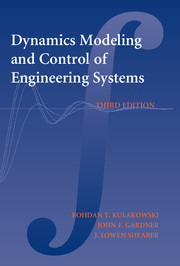Book contents
- Frontmatter
- Contents
- Preface
- Dynamic Modeling and Control of Engineering Systems
- 1 INTRODUCTION
- 2 MECHANICAL SYSTEMS
- 3 MATHEMATICAL MODELS
- 4 ANALYTICAL SOLUTIONS OF SYSTEM INPUT–OUTPUT EQUATIONS
- 5 NUMERICAL SOLUTIONS OF ORDINARY DIFFERENTIAL EQUATIONS
- 6 SIMULATION OF DYNAMIC SYSTEMS
- 7 ELECTRICAL SYSTEMS
- 8 THERMAL SYSTEMS
- 9 FLUID SYSTEMS
- 10 MIXED SYSTEMS
- 11 SYSTEM TRANSFER FUNCTIONS
- 12 FREQUENCY ANALYSIS
- 13 CLOSED-LOOP SYSTEMS AND SYSTEM STABILITY
- 14 CONTROL SYSTEMS
- 15 ANALYSIS OF DISCRETE-TIME SYSTEMS
- 16 DIGITAL CONTROL SYSTEMS
- APPENDIX 1 Fourier Series and the Fourier Transform
- APPENDIX 2 Laplace Transforms
- APPENDIX 3 MATLAB Tutorial
- APPENDIX 4 Simulink Tutorial
- Index
16 - DIGITAL CONTROL SYSTEMS
Published online by Cambridge University Press: 05 June 2012
- Frontmatter
- Contents
- Preface
- Dynamic Modeling and Control of Engineering Systems
- 1 INTRODUCTION
- 2 MECHANICAL SYSTEMS
- 3 MATHEMATICAL MODELS
- 4 ANALYTICAL SOLUTIONS OF SYSTEM INPUT–OUTPUT EQUATIONS
- 5 NUMERICAL SOLUTIONS OF ORDINARY DIFFERENTIAL EQUATIONS
- 6 SIMULATION OF DYNAMIC SYSTEMS
- 7 ELECTRICAL SYSTEMS
- 8 THERMAL SYSTEMS
- 9 FLUID SYSTEMS
- 10 MIXED SYSTEMS
- 11 SYSTEM TRANSFER FUNCTIONS
- 12 FREQUENCY ANALYSIS
- 13 CLOSED-LOOP SYSTEMS AND SYSTEM STABILITY
- 14 CONTROL SYSTEMS
- 15 ANALYSIS OF DISCRETE-TIME SYSTEMS
- 16 DIGITAL CONTROL SYSTEMS
- APPENDIX 1 Fourier Series and the Fourier Transform
- APPENDIX 2 Laplace Transforms
- APPENDIX 3 MATLAB Tutorial
- APPENDIX 4 Simulink Tutorial
- Index
Summary
LEARNING OBJECTIVES FOR THIS CHAPTER
16–1 To develop open-loop and closed-loop transfer functions in the z domain for simple digital control systems.
16–2 To evaluate stability and transient performance of linear discrete-time systems.
16–3 To assess steady-state performance of discrete-time systems.
16–4 To implement a discrete-time equivalent of a PID controller.
INTRODUCTION
Unprecedented advances in electronics have revolutionized control technology in recent years. Digital controllers, built around microcomputer chips as stand-alone units or implemented with ubiquitous personal computers, have dominated modern industrial process control applications. The computational power and operational speed of digital controllers allow for performance of much more sophisticated algorithms than were possible with analog controllers. Even for relatively simple control tasks, digital controllers are superior to analog controllers by virtue of their improved flexibility, greater reliability, and, more and more often, lower cost.
The main objective of this chapter is to introduce the very basic concepts of analysis of digital control systems. Only linear, stationary models are considered. In Section 16.2, a pulse transfer function block diagram of a single-loop digital control system is presented. Section 16.3 deals with transient characteristics determined by the locations of roots of the system characteristic equation; methods for determining stability are also briefly discussed. In Section 16.4, steady-state performance characteristics of digital control systems are reviewed. Section 16.5 provides introductory material on digital control algorithms. A digital version of the PID controller is given special attention because of its popularity in industrial process control applications.
- Type
- Chapter
- Information
- Dynamic Modeling and Control of Engineering Systems , pp. 410 - 426Publisher: Cambridge University PressPrint publication year: 2007



